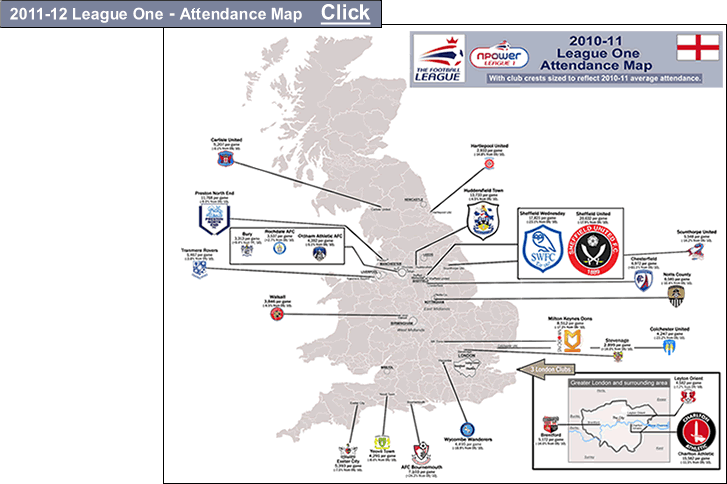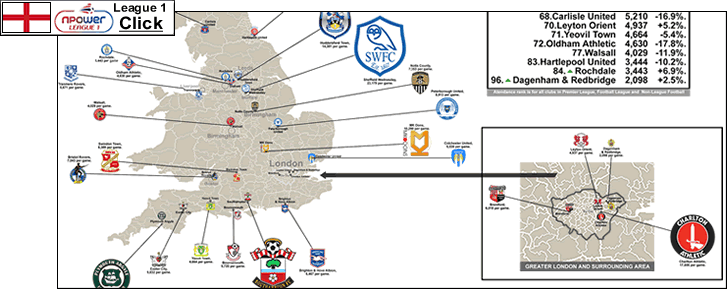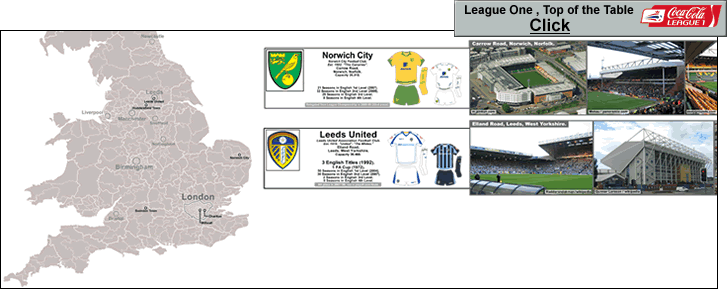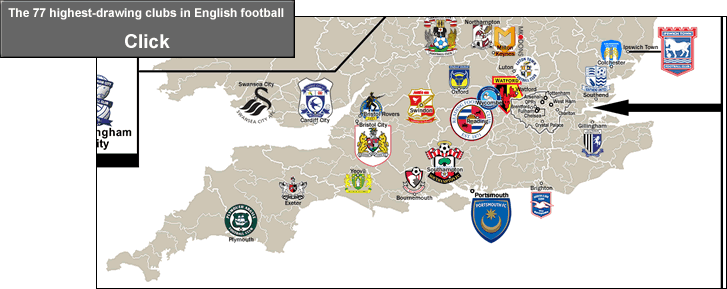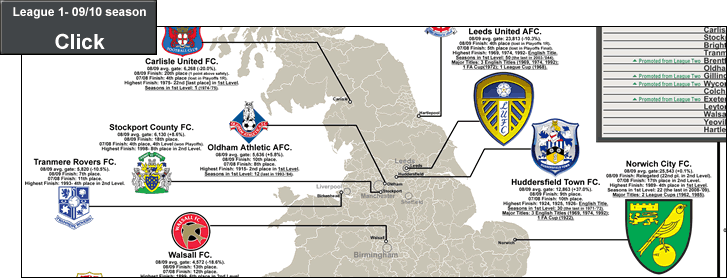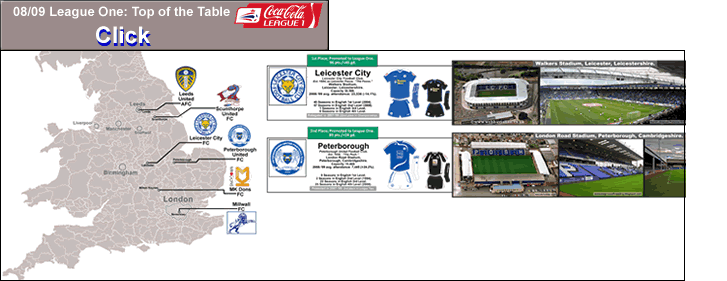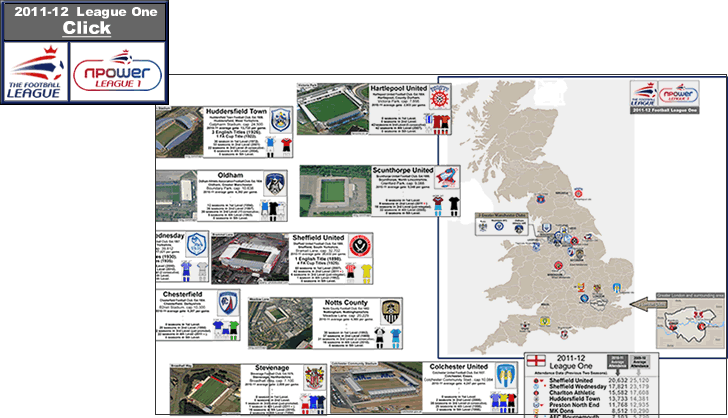
2011-12 League One, Stadia map
…
…
Note: to see my latest post of English 3rd division, click on the following, category: Eng,3rd Level/League One.
…
As of 1 November, 2011, after all clubs in the league have played 16 games, Charlton Athletic lead over Huddersfield Town by 3 points; with Sheffield Wednesday, Sheffield United, MK Dons, and Notts County in the play-off places. Rochdale, Chesterfield, Wycombe Wanderers, and Yeovil Town make up the clubs in the relegation zone.

Large aerial photo by Dean Nicholas via SFist.com. Small aerial photo of The Valley by Tom Shaw/Getty Images Europe via Zimbio.com/Aerial Views Of London Football Stadiums [Gallery].
Football League One is the 3rd Level of the English Football system. League One is the league which, most seasons, has the widest disparity of club size (as measured by average attendance). To be very general about it, you can divide the sort of clubs that are in any given League One season into 3 categories…
A) Medium-to-medium/large-sized clubs with more than 2 dozen seasons in the top flight, that have maybe won a few major titles, and have (and maybe at a stretch) the ability to average near or above 20,000 per game. In this category, this season, there are 5 clubs that fit this criteria – Charlton Athletic, Huddersfield Town AFC, Preston North End, Sheffield United, and Sheffield Wednesday. These clubs have fallen on hard times and now must rub shoulders with clubs who don’t even have stadiums larger than 10 or 12K capacity – clubs who have never even made it to the second division, let alone the top tier.
B). 3rd Level/League One mainstays. Clubs who have historically been found at the 3rd Level more than any other level, or who have slightly more seasons-spent in the 2nd Level (2 clubs, denoted in the following list by an asterisk). The 11 clubs in this category [for 2011-12] are Bournemouth, Brentford, Carlisle United, Chesterfield, Colchester United, Exeter City, *Leyton Orient, *Notts County, Oldham Athletic AFC, Tranmere Rovers, and Walsall. These clubs generally average between 4,000 to 7,000 per game. The higher-drawing of these 11 clubs are Bournemouth, Chesterfield and Notts County, who these days usually draw in the 6K to low-7K region. The middle-drawing of these 11 clubs are Tranmere, Exeter, Carlisle, Brentford, and Oldham, who usually draw in the mid-4K to mid-5K region. And the lower-drawing of these 11 clubs are Walsall, Colchester, and Leyton Orient, who these days usually draw in the high-3K to mid-4K range.
C). Clubs who have punched above their weight to get here, and who draw lower than the clubs listed above (usually drawing between 2,500 to 5,500 per game) and whose realistic goal, most seasons, is to remain at this level (7 clubs). Of course, these clubs can try to live the dream, as it were, and that is what you could call Scunthorpe United’s run for the last 6 seasons, which has included 2 spells and 3 seasons in the 2nd Level (the League Championship) for the plucky North Lincolnshire side – this from a club that has spent 39 seasons in the 4th Level, just 19 seasons in the 3rd Level, and only 9 seasons in the 2nd Level, 6 of which were before 1965. You also will find clubs in this category who have been in the 2nd Level somewhat recently (like Bury, last in 1999), or clubs that just fell short of a Cinderella-story promotion to the second division (like Yeovil Town, in 2006-07). You can sub-divide this category into C-1), Clubs who have been in the Football League for decades; and C-2), Clubs who never had a shot at the Football League until 1979-80, when automatic promotion/relegation was instituted between Non-League football and the 4th Level of the Football League. For the 2011-12 League One season, those C-1 clubs would be Bury, Hartlepool United, Rochdale AFC, and Scunthorpe United; the C-2 clubs are Stevenage, Wycombe Wanderers, and Yeovil Town. It is worth noting that these latter 3 clubs have all spent more seasons in the 3rd Level/League One than in the 4th Level/League Two.
That’s 23 clubs, what about the 24th?. Well, MK Dons belong in a special category all their own (thank goodness) – a club that stole another club’s league placement and history (Wimbledon FC), then moved the ‘franchise’ out of that club’s area (South London) into another area (in 2004, to Milton Keynes, Buckinghamshire, which is around 71 km./44 miles north of London).
…
The map page shows an exterior or an aerial photo (or satellite image) of each football club’s ground. 2010-11 average attendances, 2009-10 average attendances, and league movement (if any) are listed at the lower right of the map page. Above that is a location-map of the 24 clubs in the 2011-12 League One season. By each club’s stadia photo is club and stadium info, 2011-12 kits, and the 5-level league history of the club.
I added 5th-Level-history because 3 clubs – Carlisle United, Colchester United, and Exeter City – have had a season or two (or five) in the wilderness of Non-League Football recently; and because 3 clubs – Stevenage, Wycombe Wanderers, and Yeovil Town – never had any League history before 1979-80. That season was when election to the Football League was replaced by the more democratic on-field promotion and relegation system that had already been in place in the Football League then for almost a Century. Since the elimination of that barrier, clubs like Stevenage, Wycombe Wanderers, and Yeovil Town have moved up the ladder and firmly established themselves in the Football League. You could call these 3 clubs the best argument for why there should be 3, and not just 2, clubs promoted from Non-League football each year.
…
Below are the top 3 scorers in the 2011-12 League One season after 16 games – Bradley Wright-Phillips, Gary Medine, and Jordan Rhodes…

Photo credits – CAFC.co.uk. SWFC/galley. Bruce Rollinson/thestar.co.uk.
…
Image credits on map page –
Carlisle United, aerial photo of Brunton Park from VisitCumbria.com.
Preston North End, http://www.deepdalestadium.co.uk/stadium_gallery/.
Huddersfield Town, satellite image from Bing.com/maps [found at each club's stadium page at en.wikipedia.org/click on the (blue-lit) coordinates of stadium/click on Bing.com's Bird's Eye satellite view, here.
Hartlepool United, Fanzone.co.uk.
Tranmere Rovers, Tranmererovers.co.uk.
Bury, 'Flightsandlessons.com'.
Rochdale AFC, Bing.com/maps.
Oldham Athletic AFC, Bing.com/maps.
Scunthorpe United, Bing.com/maps.
Sheffield Wednesday, the photo of Hillsborough was taken from by a camera suspended from the frame of a manned kite glider, Rob Huntley-Kite Aerial Photography.
Sheffield United, pparry at Photobucket.com.
Chesterfield, chesterfield-fc.co.uk.
Notts County, Bing.com/maps.
Walsall, Mediastorehouse.com/Bescot Stadium.
MK Dons, Bing.com/maps.
Stevenage, Bing.com/maps.
Colchester United, Colchester.gov.uk.
Wycome Wanderers, photo by DipseyDave at 'Adams Park' (en.wikipedia.org).
Brenrford, Bing.com/maps.
Leyton Orient, photo by Tom Shaw/Getty Images Europe via Zimbio.com/Aerial Views Of London Football Stadiums [Gallery]
Charton Athletic, photo by Tom Shaw/Getty Images Europe via Zimbio.com/Aerial Views Of London Football Stadiums [Gallery].
Exeter City, Bing.com/maps.
Yeovil Town, ytfc.net.
AFC Bournemouth, Bing.com/maps.
Thanks to the contributors to the pages at en.wikipedia.org, ‘2011–12 Football League One‘.
Thanks to European-football-statistics.co.uk, for attendance data.
Thanks to these two sites…
1). Data for ‘Seasons spent in Levels’ lists, thanks to http://stats.football365.com/hist/tier3/attable.html [data up to 2001-02].
2). For league placement data from 2002-03 and on, plus general data on the clubs’ league placement through the years, thanks to Footy-Mad.co.uk sites of each club, usually [at the top menu bar there] at ‘Club/League History’. Example, Carlisle United’s Footy-Mad page/Club/League History.
